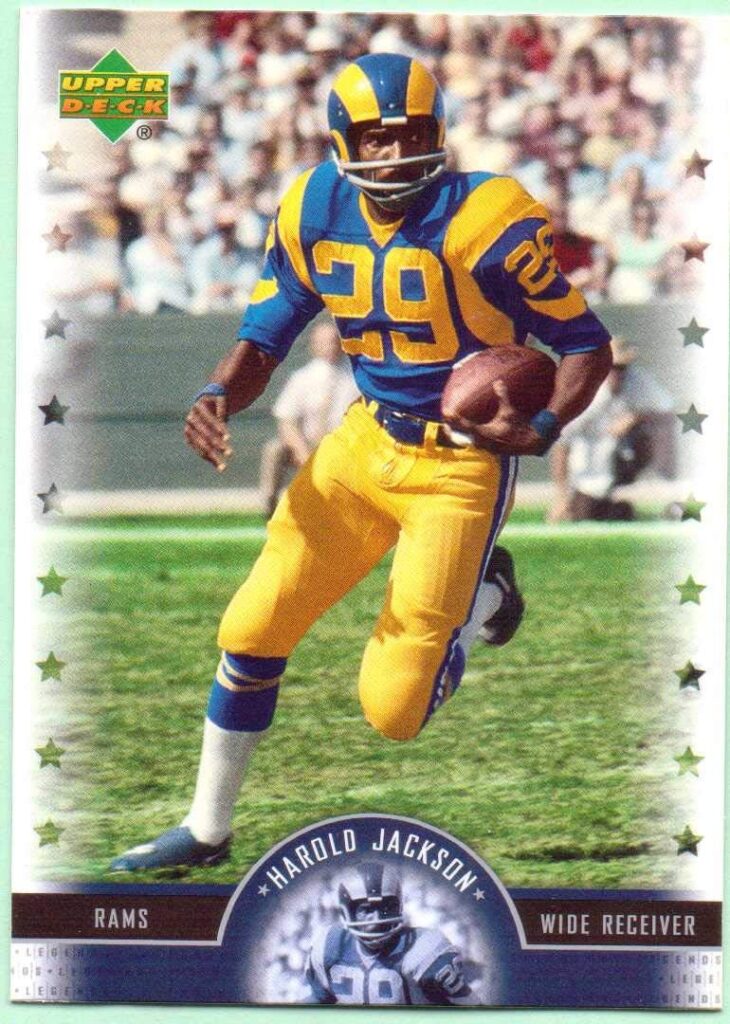Harold Jackson: Unsung Star WR
The Sports Then and Now Vintage Athlete of the Month is one of the most underappreciated wide receivers in NFL history, despite boasting a career that spanned 16 seasons and saw him excel as one of the league’s premier deep threats. Known for his speed, route-running, and ability to make plays downfield, Harold Jackson left an indelible mark on the game during an era that was not yet pass-heavy. Standing at 5’10” and weighing 175 pounds, he defied expectations of size to become a dominant force on the field. Over the course of his illustrious career (1968–1983), Jackson totaled 10,372 receiving yards and 76 touchdowns, placing him among the top receivers of his time.
Early Career and Breakout Seasons
Born on January 6, 1946, in Hattiesburg, Mississippi, Jackson played college football at Jackson State University, a historically Black college known for producing NFL talent. He was drafted in the 12th round of the 1968 NFL Draft by the Los Angeles Rams, a team that initially used him sparingly. After being traded to the Philadelphia Eagles in 1969, Jackson began to showcase his talent. His breakout came in 1972 when he led the NFL in receptions (62), receiving yards (1,048), and touchdowns (13). This remarkable season established Jackson as one of the league’s premier wideouts and earned him the first of his five Pro Bowl selections.
Jackson’s ability to stretch the field was unparalleled. Playing during an era when passing games were less prominent and defensive backs were allowed to be far more physical, he consistently found ways to get open. His blazing speed and knack for tracking the ball made him a favorite target for quarterbacks, and his production rarely faltered despite playing for teams that often struggled offensively.
Prime Years with the Rams
In 1973, Jackson returned to the Los Angeles Rams, where he enjoyed some of the best years of his career. Paired with quarterbacks such as John Hadl and later Pat Haden, Jackson thrived in the Rams’ offense, which utilized his ability to stretch defenses with big plays. In his first season back in Los Angeles, Jackson recorded 40 receptions for 874 yards and 13 touchdowns, leading the league in touchdown receptions. His consistent production helped propel the Rams to become perennial playoff contenders during the mid-1970s.
From 1973 to 1977, Jackson was one of the NFL’s most reliable receivers, regularly finishing among the league leaders in yards per reception. He had a knack for making crucial plays, whether it was a long touchdown pass or a critical third-down conversion. His ability to adjust to underthrown or contested balls made him an invaluable asset to his team. In 1973, Jackson earned first-team All-Pro honors, cementing his status as one of the league’s elite wideouts.
Transition to the Patriots and Later Years
In 1978, Jackson was traded to the New England Patriots, where he continued to perform at a high level despite being in the latter stages of his career. During his three seasons with the Patriots, Jackson recorded over 2,300 receiving yards and 18 touchdowns, proving that his speed and skills had not diminished. He played a vital role in helping the Patriots remain competitive during that period, including a playoff appearance in 1978.
After his time in New England, Jackson played brief stints with the Minnesota Vikings and a return to the Rams before retiring in 1983. By the end of his career, Jackson had accumulated 579 receptions, 10,372 receiving yards, and 76 touchdowns. At the time of his retirement, he ranked among the top five all-time in receiving yards, a testament to his longevity and productivity.
Legacy and Hall of Fame Debate
Despite his impressive statistics, Harold Jackson’s contributions have often been overlooked when discussing the greatest receivers in NFL history. He played during an era when the passing game was not as emphasized as it is today, making his achievements even more remarkable. His five Pro Bowl selections, two first-team All-Pro honors, and two seasons leading the league in receiving yards highlight his dominance in the 1970s. One reason for the lack of widespread r
